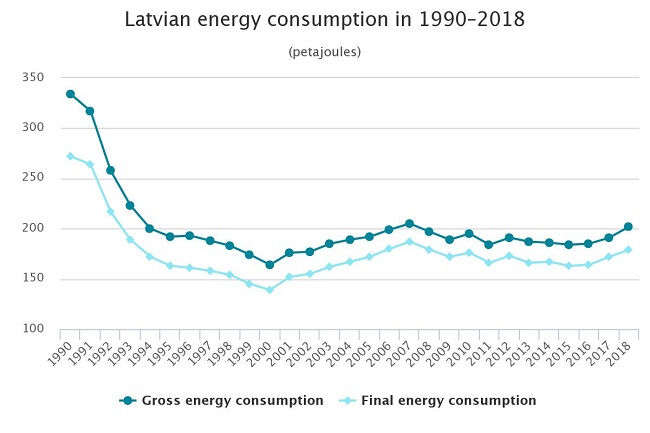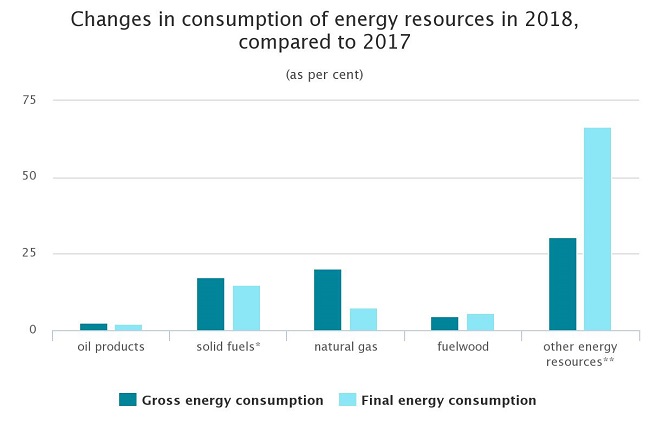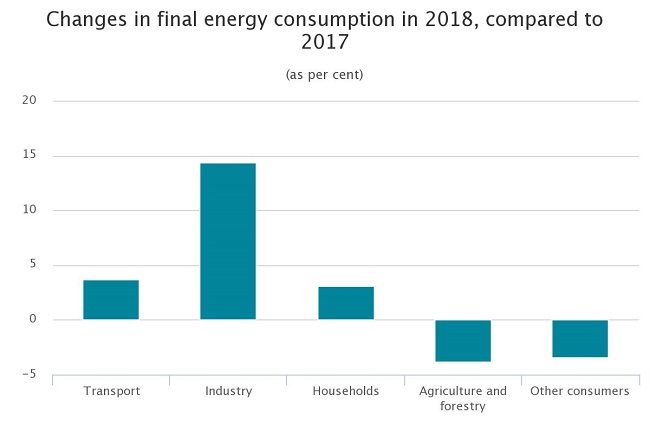Analytics, Energy, Energy Market, Latvia, Statistics
International Internet Magazine. Baltic States news & analytics
Saturday, 13.12.2025, 17:14
Energy consumption upturn in both production and consumption in Latvia
 Print version
Print versionIn 2018, compared to 2017, the gross consumption of renewables went up by 5.7%, and the amount of renewables produced grew by 10.0%. Significant rise was recorded in the firewood production (by 20.0% or 17.0 PJ), whereas primary electricity production2 fell by 43.6% or 7.1 PJ – by 44.5% in hydro power plants and by 18.6% in wind power plants. Hydro power plants and wind power plants together produced 2 554 GWh of electricity – 2 432 GWh and 122 GWh, respectively.
Last year, the small amount of electricity generated in hydro power plants, which may be explained by unusually dry and long summer leading to low water level and small water inflow in river Daugava, had the greatest downward effect on the amount of electricity produced.

Upturn in the share of renewables in gross energy consumption
Over the recent years, the structure of gross energy consumption has changed – as the share of natural gas is declining and the proportion of renewables is growing. Over the past ten years (from 2009 to 2018), the share of natural gas consumption fell by 4.6 percentage points, constituting 24.8% in 2018, whereas the share of renewables reached 33.4%. At the same time, share of firewood consumption grew by 2.9 percentage points, constituting 30.7% in 2018. Compared to 2017, in 2018 the amount of wood chips produced rose by 10.8%, of firewood by 22.1%, and of pelleted wood by 22.1%. Last year, 30.9 PJ of pelleted wood were produced, which is 9.9% more than in 2017.
As the gross consumption of renewables is increasing, Latvia is getting closer to its strategic objective regarding use of renewable energy resources aiming at reaching 40% of the energy produced from renewables in the gross final energy consumption until 2020. Latvia has the third highest share of renewables in the final energy consumption in the European Union (EU); in 2017, the indicator constituted 39.0% (EU average 17.5%). The EU Member States shall ensure that until 2020 the share of renewables consumed in transport sector is 10%. In 2017, Latvian share of renewables in transport constituted 2.5% and EU average 7.6%.

Last year, amount of electricity produced gone up by 9.6 %
In 2018, 58.1 PJ of energy resources were consumed for production of heat and electricity (in transformation sector3) and 44.7 PJ of energy were produced (of which 29.7 PJ of heat and 15.0 PJ of electricity), which is 9.6 % more than in 2017. Hot and dry weather hindered Latvian hydro power plants from producing the electricity amount needed, which, in turn, facilitated rise in the natural gas consumption in transformation sector leading to the rise in the share of natural gas consumed in the sector of 5.2 percentage points, compared to 2017. Production of heat and electricity in Latvia mainly is based on fossil fuel – natural gas, the share thereof in transformation sector has been decreasing gradually: 81% in 2010, 53.7% in 2017 and 59.0% in 2018. Over the past five years, the share of renewables consumed in transformation sector has risen by 5.4 percentage points reaching 40.5% in 2017. It may be assessed as a positive trend, bearing in mind that the renewables used in transformation sector are local resources firewood, biogas and other biomass.
In 2018, final energy consumption constituted 179.1 PJ, which is 4.3% more than in 2017. Over the last ten years, no notable changes were recorded in the final energy consumption. Last year, transport sector consuming 30.1% of the energy resources, households (28.8%) and industry (22.9%) were the largest consumers of energy sources. Compared to 2017, last year a rise in the final energy consumption was recorded in transport (of 3.7%), industry (14.4%), and households (3.1%), while decline in agriculture and forestry (of 3.8%) as well as amount consumed by other consumers (3.4%).

One third of energy resources consumed in transport sector
Over the past five years, consumption of energy resources in transport sector has gone up by 16.4%, reaching 53.9 PJ in 2018. The sector takes approximately one third of the Latvian consumption of energy resources and almost fully is based on oil product imports, as the share of electricity and biofuel in the sector is comparatively small. Diesel oil is the main source used in the transport sector, and the share thereof constituted 64.3% in 2018. During the recent years, significant increase in the share of liquefied petroleum gas (LPG) consumed in transport sector may be observed. In 2010, the indicator constituted 1 PJ, whereas in 2018 – 2.3 PJ (2.3 times more). In its turn, compared to 2017, the consumption of LPG has dropped by 5.2%. Over the past five years, consumption of motor petrol in transport sector has declined by 10.6%, reaching 7.7 PJ in 2018, which is 4.1% less than in 2017.
Greatest consumption of energy resources in industry recorded in manufacture of wood and of products of wood and cork
During the last five years, consumption of energy resources in industry rose by 12.8%, reaching 41.1 PJ in 2018. Last year, the greatest consumption of energy resources was recorded in manufacture of wood and of products of wood and cork – 20.7 PJ or 50.4% of the final energy consumption in industry. Compared to 2017, energy consumption in this sector has grown by 5.5%, as the consumption of pelleted wood rose. Last year, manufacture of basic metals indicated the most notable decline in the consumption of energy resources – of 7.9%, compared to 2017.
Notable increase in natural gas consumption in household sector
In 2018, consumption of energy resources in households amounted to 51.7 PJ, which is 3.1% more than in 2017. Structure of energy resource consumption in households has not changed notably over the recent years – firewood is the most commonly used energy resource. Compared to 2017, consumption of natural gas in households has risen notably (by 9.3%), while consumption of coal has declined (by 32.7%).








 «The Baltic Course» Is Sold and Stays in Business!
«The Baltic Course» Is Sold and Stays in Business!

